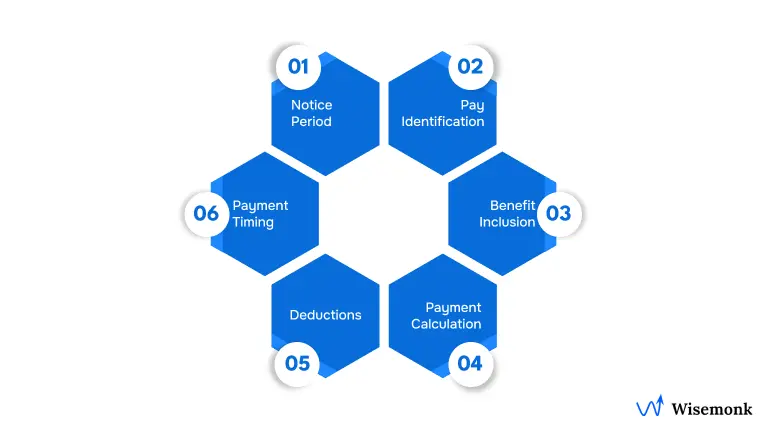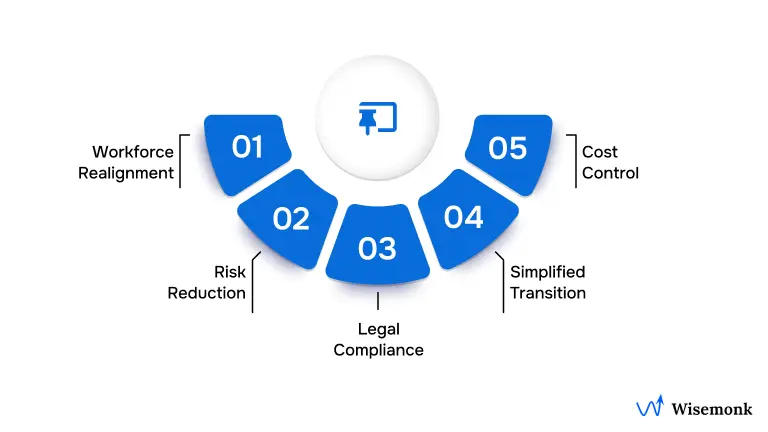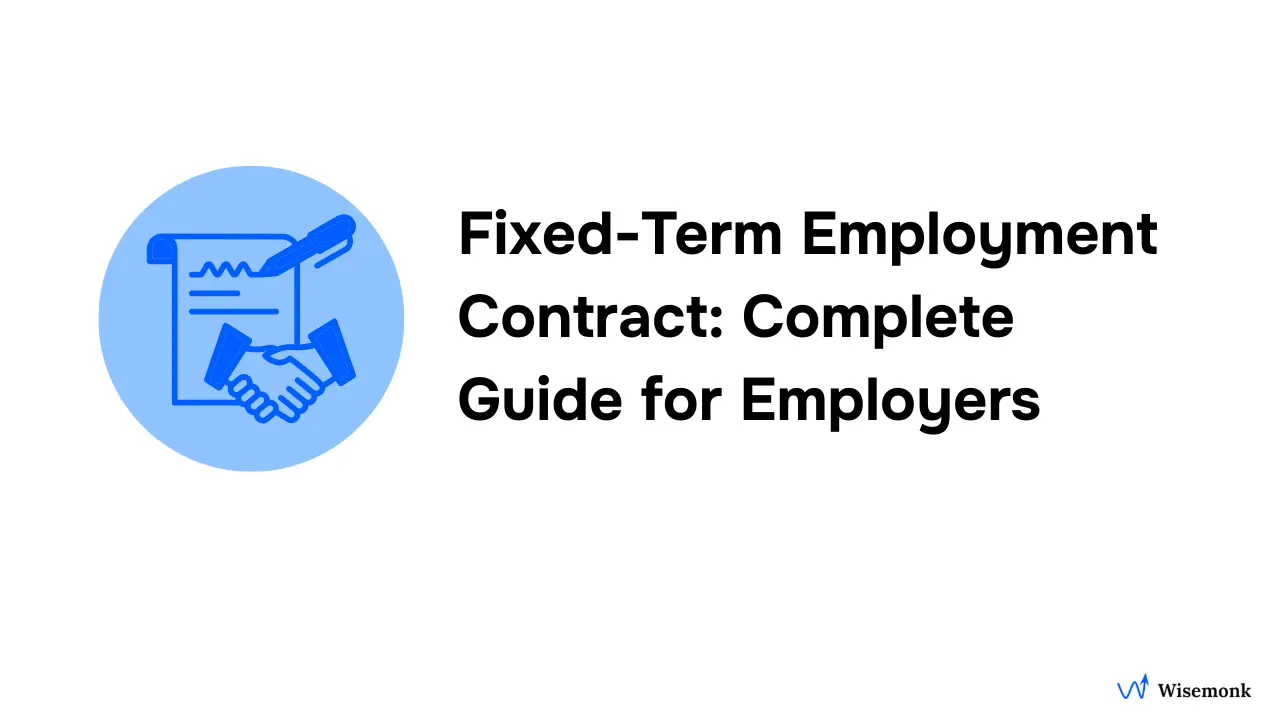- Wages in lieu of notice, also known as Payment in Lieu of Notice (PILON), is a payment an employer makes to an employee instead of requiring them to work through their notice period.
- Payment in lieu of notice (PILON) allows employers to end employment immediately by paying the employee for the notice period, helping manage risks like data leaks or workplace disruption.
- The key considerations when offering payment in lieu of notice are ensuring it aligns with contract terms, follows correct tax rules, and covers benefits like insurance or pensions.
- To calculate payment in lieu of notice (PILON), review the employee’s notice period, regular pay, and benefits, multiply them by the notice duration, include deductions, and ensure timely payment per local laws.
Need help understanding wages in lieu of notice? Talk to our experts today.
Discover how Wisemonk creates impactful and reliable content.
What if you need to let an employee go but don’t want them working through their notice period? Don’t worry; wages in lieu of notice handle that situation perfectly. For US employers, founders, and HR leaders navigating employee exits, understanding how this works can prevent compliance headaches and payroll errors.
In this article, we’ll walk you through how it works, when to apply it, and how to stay compliant while keeping transitions smooth.
What are wages in Lieu of Notice?[toc=Wages in Lieu of Notice]
Wages in lieu of notice, also known as payment in lieu of notice (PILON), refer to the payment an employer provides to an employee instead of requiring them to serve their notice period when employment ends. This payment typically includes the salary and benefits the employee would have earned during that period.
Employers use this option to terminate employment immediately while still fulfilling legal or contractual obligations. It helps organizations manage workforce changes efficiently and avoid potential disruptions, confidentiality risks, or operational issues that might arise if the employee remained during the notice period.
This practice is commonly applied in cases of termination, redundancy, or mutual contract conclusion where a quick and compliant separation is preferred.
When do employers use wages in lieu of notice (PILON)?[toc=When to Use]
Employers may opt to provide wages in lieu of notice (PILON) under various circumstances to facilitate a swift and efficient separation process.
From our extensive experience helping global companies manage compliant offboarding and workforce transitions, here are when employers use Payment in Lieu of Notice (PILON).
- Redundancy or layoffs due to business restructuring.
- Breach of contract by the employee requiring immediate termination.
- Mutual agreements between employer and employee to end employment early.
- Immediate dismissal for misconduct or poor performance.
- Protecting sensitive company information by preventing the employee from remaining on-site during the notice period.
- When the employment contract specifically allows payment in lieu of notice.
Pro tip: Always document the reason for using PILON in writing, this record can protect your company in wrongful-dismissal or unemployment-benefit disputes later.
How do payments in lieu of notice relate to employment contracts?[toc=PILON and Employment Contracts]
A payment in lieu of notice (PILON) clause in an employment contract allows an employer to end the employment relationship immediately by paying the employee’s base salary for the notice period instead of requiring them to work it. Without this clause, ending employment without notice could be considered a breach of contract.
What employers need to know about employment contracts
Employers should ensure every employment contract includes a clear notice provision outlining:
- The right to pay wages in lieu of notice for immediate termination.
- How the gross amount of wages in lieu of notice will be calculated, including base salary and benefits.
- That payments are taxable income, subject to income tax and payroll deductions.
- Compliance with local labor laws to avoid legal risks or wrongful dismissal claims.
What if there’s no PILON clause in the contract
If no clause exists, the employer can’t automatically pay instead of notice, doing so could breach the employee’s contract.
In that case:
- Get the employee’s written consent to accept a lump-sum notice payment.
- Consult employment lawyers to prevent legal disputes.
- Update future contracts with a clear payment in lieu of notice clause to ensure compliance.
Complementary resource: You might be interested in knowing about fixed-term employment contracts, read our blog on "Fixed-Term Employment Contracts: Explained".
How does payment in lieu of notice (PILON) work?[toc=How PILON Works]
Calculating Payment in Lieu of Notice (PILON) involves determining the amount an employer must pay an employee instead of requiring them to work through their notice period.
What do wages in lieu of notice include
- The employee’s regular salary or hourly wage applicable during the notice period.
- Base pay only, unless bonuses, overtime, or commissions are part of regular earnings.
- Additional benefits such as allowances or company perks, depending on the employment contract and local labor laws.
How do you calculate the gross amount of wages in lieu of notice

Here’s a simple step-by-step process to help employers calculate PILON:
- Determine the Notice Period: Review the employee's contract to identify the required notice period. If no notice period is specified, the employer may choose the appropriate notice based on company policy or industry standards (typically one or two weeks).
- Identify the Employee’s Regular Pay: Determine the employee’s regular salary or hourly wage that would be applicable during the notice period. This should include base pay but exclude bonuses, overtime, or commissions unless these are part of their regular earnings.
- Include Additional Benefits (if applicable): In some cases, certain benefits like allowances or company perks might be included in the calculation. These will depend on the terms of the employment contract and local labor laws.
- Calculate the Total Payment: Multiply the employee's daily, weekly, or monthly salary by the length of the notice period (depending on the contract). If calculating for a non-full-time employee, convert their wages to the full-time equivalent for clarity.
- Example: If the employee is entitled to 1 month’s notice and has a monthly salary of $3,000, then the PILON would be $3,000.
- Deductions (if applicable): Depending on the situation, certain deductions may be necessary. This could include any outstanding loan repayments, advances, or damages to company property.
- Payment Timing: Ensure the payment is made per local regulations, often within a specified number of days after termination.
Example Calculation
Let’s say an employee has a monthly salary of $3,000 and is entitled to a one-month notice period. However, the employer chooses to pay them PILON instead of requiring them to work out the notice period.
- Step 1: Notice period = 1 month
- Step 2: Monthly salary = $3,000
- Step 3: Total PILON payment = $3,000 (since the employee was to receive one month’s notice)
Therefore, the employer would pay the employee $3,000 in lieu of notice.
This ensures the employee receives compensation reflecting all relevant salary components and earned benefits during the notice period.
Is payment in lieu of notice the same as severance pay?[toc=PILON vs. Severance Pay]
No, payment in lieu of notice (PILON) and severance pay are not the same. Both are paid when an employee leaves, but they serve very different purposes and are triggered under different conditions.
Here’s the quick difference:
- PILON is paid when an employer ends employment immediately and chooses to pay wages for the notice period instead of having the employee work it.
- Severance pay is a lump-sum compensation given after termination, usually due to redundancy or restructuring, based on the employee’s length of service.
- PILON covers the notice period, while severance pay compensates for job loss, both are taxable income under standard payroll and employment law rules.
If you’re curious how severance works, check out our in-depth guide on "Severance Pay: Comprehensive Guide" to understand rules, calculations, and employer obligations.
What distinguishes PILON from garden leave?[toc=PILON vs. Garden Leave]
While both Payment in Lieu of Notice (PILON) and garden leave are related to the termination of employment, they serve different purposes and have distinct implications.
- PILON: This involves providing an employee with payment instead of requiring them to work through their notice period. The employee is compensated for the notice period without having to continue working. This method allows for an immediate separation from the company.
- Garden Leave: On the other hand, garden leave refers to a situation where an employee is placed on paid leave during their notice period, but remains technically employed. During this time, they are not required to perform any work, but still receive their salary and benefits. Garden leave is often used when an employer wants to ensure that the employee does not have access to sensitive information or influence other employees before leaving.
Fact: According to UK government guidance, during garden leave, an employee “is told not to come into work, but you’ll get the same pay and contractual benefits".
What are the key legal considerations for wages in lieu of notice in the US?[toc=Legal Considerations]
In the U.S., the rules surrounding wages in lieu of notice (PILON) depend on employment contracts, federal laws, and specific termination scenarios. Unlike many other countries, the U.S. generally does not mandate statutory notice periods, except in specific contexts like mass layoffs under the WARN Act.
- At-Will Employment: Most U.S. employment is at-will, allowing employers to terminate employees without notice. However, if an employment contract or collective bargaining agreement specifies a notice period or PILON, the employer must comply to avoid breach of contract.
- WARN Act: The Worker Adjustment and Retraining Notification (WARN) Act covers employers conducting mass layoffs or plant closures. The Act requires employers to provide 60 days’ notice or pay wages in lieu of notice for mass layoffs or plant closures that affect 50 or more employees.
- Gross Misconduct: Employees terminated for gross misconduct (e.g., theft, violence) are generally not entitled to PILON, as employers can dismiss them immediately without notice.
Understanding these key legal aspects helps employers manage PILON obligations and avoid legal issues during employee separations.
What are the tax implications of payment in lieu of notice in the US?[toc=Tax Implications]
When paying wages in lieu of notice (PILON), employers must ensure they handle the tax implications properly to remain compliant with U.S. tax laws. Here are the key tax considerations:
- Taxable Income: PILON is considered part of the employee’s regular wages and is taxed at the employee’s marginal income tax rate. It is not eligible for any tax exemptions or special treatment, unlike certain severance payments in other jurisdictions.
- Withholding Requirements: Employers are required to withhold federal income tax, Social Security tax, and Medicare tax on PILON payments, just as they would with regular wages. State and local income tax withholding may also apply, depending on the jurisdiction.
- Reporting: PILON must be included in the employee’s final paycheck and reported on their W-2 form for the tax year in which the payment is made. Employers must ensure this is done in accordance with IRS payroll reporting rules to avoid penalties.
- No Special Tax Treatment: Unlike some countries, the U.S. does not provide favorable tax treatment for PILON. It is treated as ordinary wages, and no specific exemptions or reduced rates apply.
- Social Security and Medicare: Employers must also deduct Social Security and Medicare contributions from PILON, just as they do from regular wages. These deductions must be reported and paid to the Internal Revenue Service (IRS).
Fact: According to the IRS, wages in lieu of notice are considered supplemental wages, which are typically subject to a 22% federal withholding rate when paid separately from regular wages, as outlined in IRS Publication 15-T.
What are the main benefits of offering payment in lieu of notice?[toc=Main Benefits]

Offering payment in lieu of notice (PILON) provides several advantages for employers, helping them manage workforce changes efficiently while minimizing risks. Understanding these benefits can support better decision-making during employee separations.
- Immediate Workforce Adjustment: PILON allows employers to end the employment relationship instantly without requiring the employee to serve the notice period. This helps companies respond quickly to business needs such as restructuring or downsizing.
- Reduced Operational Risks: By removing the employee from the workplace immediately, employers can protect sensitive information, maintain team morale, and avoid potential disruptions during the notice period.
- Legal Compliance: Making a payment in lieu of notice fulfills contractual and statutory obligations, reducing the risk of wrongful termination claims or labor disputes.
- Simplified Transition: PILON can streamline the separation process, making it easier to manage exit formalities and focus on onboarding new talent or reallocating resources.
- Cost Control: Although PILON requires upfront payment, it can be financially beneficial by avoiding costs associated with extended notice periods, such as supervision, reduced productivity, or potential conflicts.
Employers who understand and leverage these benefits can navigate employee separations more effectively while maintaining organizational stability. Efficient HR management and streamlined hiring processes play a crucial role in achieving this balance.
To effectively manage HR and hiring challenges, Wisemonk’s EOR services offer practical and reliable solutions.
How can Wisemonk simplify HR and hiring through EOR solutions?[toc=How Wisemonk Helps]
Wisemonk offers streamlined PEO and EOR solutions that handle the entire employment process, ensuring seamless expansion without the legal and operational headaches.
Here's what we offer:
- End-to-End Compliance: Full management of payroll, taxes, benefits, and local regulations.
- Efficient Recruitment: Access to pre-vetted talent, reducing hiring time by 40-60%.
- Seamless Onboarding and HR Support: Localized onboarding and HR assistance.
- Cost Optimization: Significant savings on operational costs compared to direct hiring.
- Global Expansion Support: Quickly scale your team without the need for local infrastructure.
Wisemonk offers a tailored solution that ensures you can focus on scaling your business while we handle the HR and hiring complexities.
Check out our pricing and contact us today to get started!
.webp)




.png)
